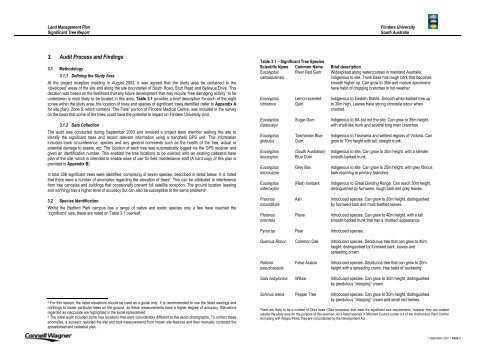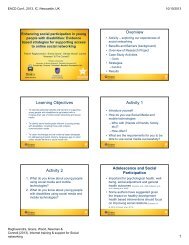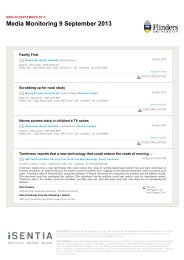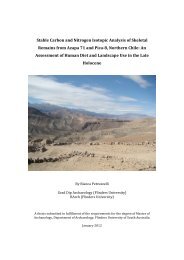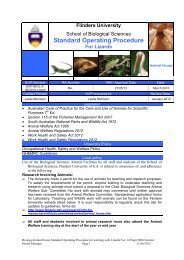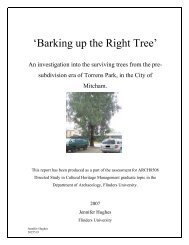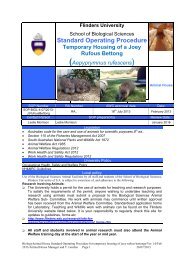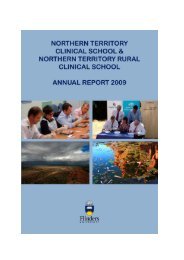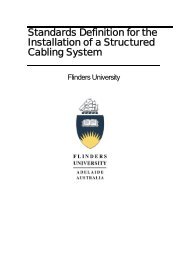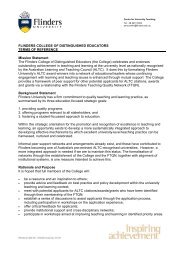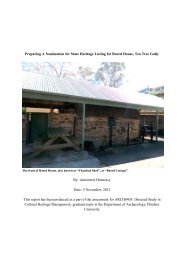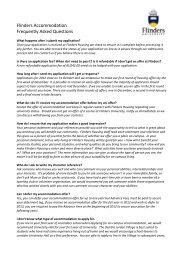Land Management Plan 2004 - 2050 Flinders University South ...
Land Management Plan 2004 - 2050 Flinders University South ...
Land Management Plan 2004 - 2050 Flinders University South ...
Create successful ePaper yourself
Turn your PDF publications into a flip-book with our unique Google optimized e-Paper software.
<strong>Land</strong> <strong>Management</strong> <strong>Plan</strong><br />
Significant Tree Report<br />
<strong>Flinders</strong> <strong>University</strong><br />
<strong>South</strong> Australia<br />
3. Audit Process and Findings<br />
3.1 Methodology<br />
3.1.1 Defining the Study Area<br />
At the project inception meeting in August 2003, it was agreed that the study area be contained to the<br />
‘developed’ areas of the site and along the site boundaries of <strong>South</strong> Road, Sturt Road and Bellevue Drive. This<br />
decision was based on the likelihood that any future development that may require “tree damaging activity” to be<br />
undertaken is most likely to be located in this area. Table 3.1 provides a brief description for each of the eight<br />
zones within the study area, the location of trees and species of significant trees identified (refer to Appendix A<br />
for site plan). Zone 5, which contains “The Flats” portion of <strong>Flinders</strong> Medical Centre, was included in the survey<br />
on the basis that some of the trees could have the potential to impact on <strong>Flinders</strong> <strong>University</strong> land.<br />
3.1.2 Data Collection<br />
The audit was conducted during September 2003 and involved a project team member walking the site to<br />
identify the significant trees and record relevant information using a handheld GPS unit. This information<br />
included trunk circumference, species and any general comments such as the health of the tree, actual or<br />
potential damage to assets, etc. The location of each tree was automatically logged via the GPS receiver and<br />
given an identification number. This enabled the tree locations to be overlaid onto an existing cadastral base<br />
plan of the site, which is intended to enable ease of use for field maintenance staff (A hard copy of this plan is<br />
provided in Appendix B).<br />
In total 206 significant trees were identified, comprising of seven species, described in detail below. It is noted<br />
that there were a number of anomalies regarding the elevation of trees 4 . This can be attributed to interference<br />
from tree canopies and buildings that occasionally prevent full satellite reception. The ground location (easting<br />
and northing) has a higher level of accuracy but can also be susceptible to the same problems 5 .<br />
3.2 Species Identification<br />
Whilst the Bedford Park campus has a range of native and exotic species only a few have reached the<br />
“significant” size, these are noted on Table 3.1 overleaf:<br />
Table 3.1 – Significant Tree Species<br />
Scientific Name Common Name Brief description<br />
Eucalyptus<br />
camaldulensis<br />
River Red Gum Widespread along watercourses in mainland Australia,<br />
indigenous to site. Trunk base has rough bark that becomes<br />
smooth higher up. Can grow to 35m and mature specimens<br />
have habit of dropping branches in hot weather.<br />
Eucalyptus<br />
citriodora<br />
Eucalyptus<br />
cladocalyx<br />
Eucalyptus<br />
globulus<br />
Eucalyptus<br />
leucoxylon<br />
Eucalyptus<br />
microcarpa<br />
Eucalyptus<br />
sideroxylon<br />
Fraxinus<br />
rotunidifolia<br />
Platanus<br />
orientalis<br />
Lemon-scented<br />
Gum<br />
Sugar Gum<br />
Tasmanian Blue<br />
Gum<br />
(<strong>South</strong> Australian)<br />
Blue Gum<br />
Grey Box<br />
(Red) Ironbark<br />
Ash<br />
<strong>Plan</strong>e<br />
Indigenous to Eastern States. Smooth white-barked tree up<br />
to 30m high. Leaves have strong citronella odour when<br />
crushed.<br />
Indigenous to SA but not the site. Can grow to 35m height,<br />
with shaft-like trunk and several long main branches.<br />
Indigenous to Tasmania and wettest regions of Victoria. Can<br />
grow to 70m height with tall, straight trunk.<br />
Indigenous to site. Can grow to 30m height, with a slender<br />
smooth-barked trunk.<br />
Indigenous to site. Can grow to 25m height, with grey fibrous<br />
bark reaching to primary branches.<br />
Indigenous to Great Dividing Range. Can reach 30m height,<br />
distinguished by furrowed, rough bark and grey leaves.<br />
Introduced species. Can grow to 20m height, distinguished<br />
by furrowed bark and multi-toothed leaves.<br />
Introduced species. Can grow to 40m height, with a tall<br />
smooth-barked trunk that has a ‘mottled’ appearance.<br />
Pyrus sp. Pear Introduced species.<br />
Quercus Robur Common Oak Introduced species. Deciduous tree that can grow to 40m<br />
height, distinguished by furrowed bark, leaves and<br />
spreading crown.<br />
Robinia<br />
pseudoacacia<br />
False Acacia<br />
Introduced species. Deciduous tree that can grow to 20m<br />
height with a spreading crown. Has habit of ‘suckering’.<br />
Salix babylonica Willow Introduced species. Can grow to 30m height, distinguished<br />
by pendulous “drooping” crown.<br />
4 For this reason, the listed elevations should be used as a guide only. It is recommended to use the listed eastings and<br />
northings to locate particular trees on the ground, as these measurements have a higher degree of accuracy. Elevations<br />
regarded as inaccurate are highlighted in the Excel spreadsheet.<br />
5 The initial audit included some tree locations that were considerably different to the aerial photographs. To correct these<br />
anomalies, a surveyor revisited the site and took measurements from known site features and then manually corrected the<br />
spreadsheet and cadastral plan.<br />
Schinus areira Pepper Tree Introduced species. Can grow to 30m height, distinguished<br />
by pendulous “drooping” crown and small red berries.<br />
There are likely to be a number of Olive trees (Olea europaea) that meet the significant size requirements, however they are located<br />
outside the study area for the purpose of this exercise. As a listed species in Mitcham Council (under s.4 of the Animal and <strong>Plan</strong>t Control<br />
Act) along with Aleppo Pines, they are not protected by the Development Act.<br />
⏐ FEBRUARY <strong>2004</strong> ⏐ PAGE 4


